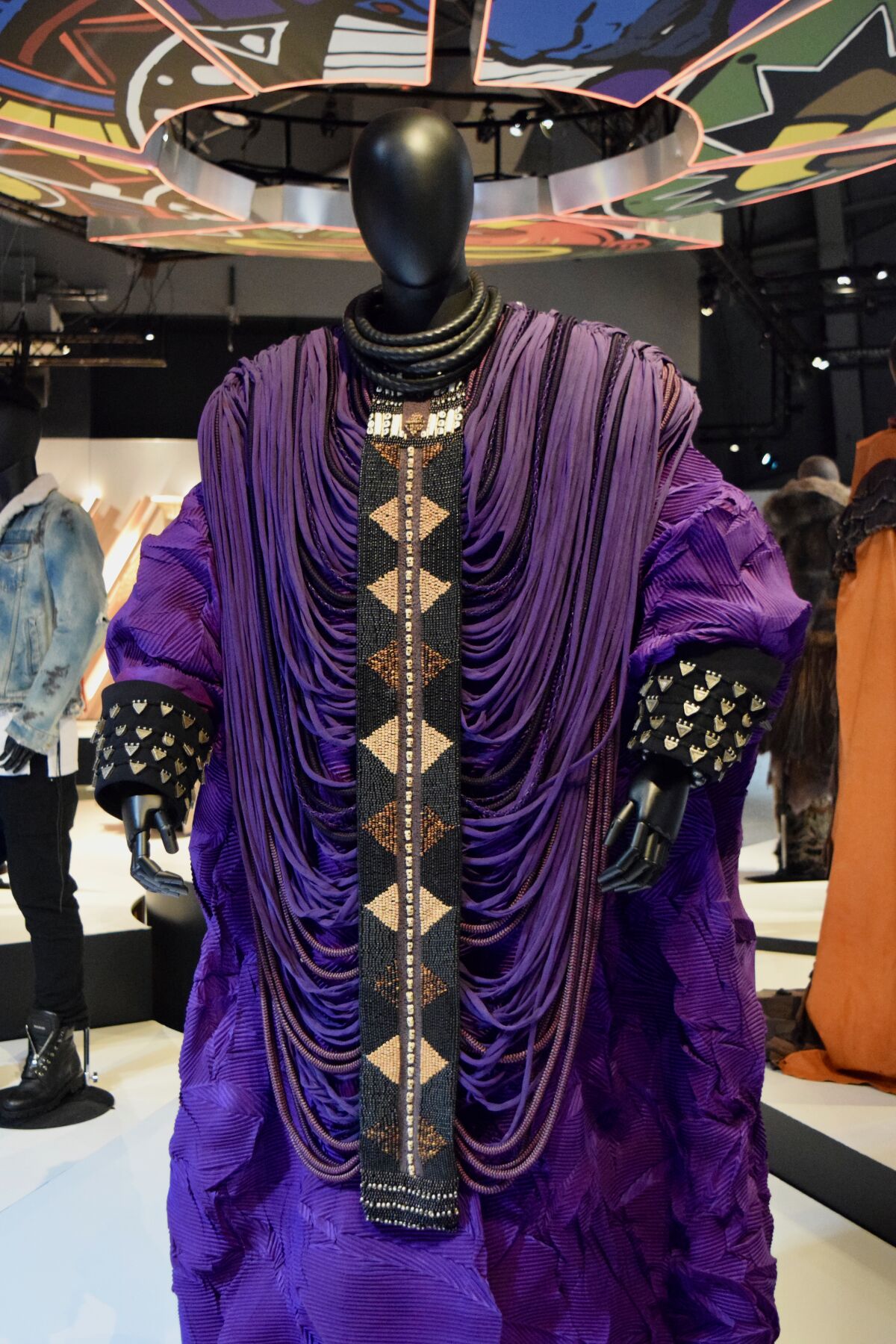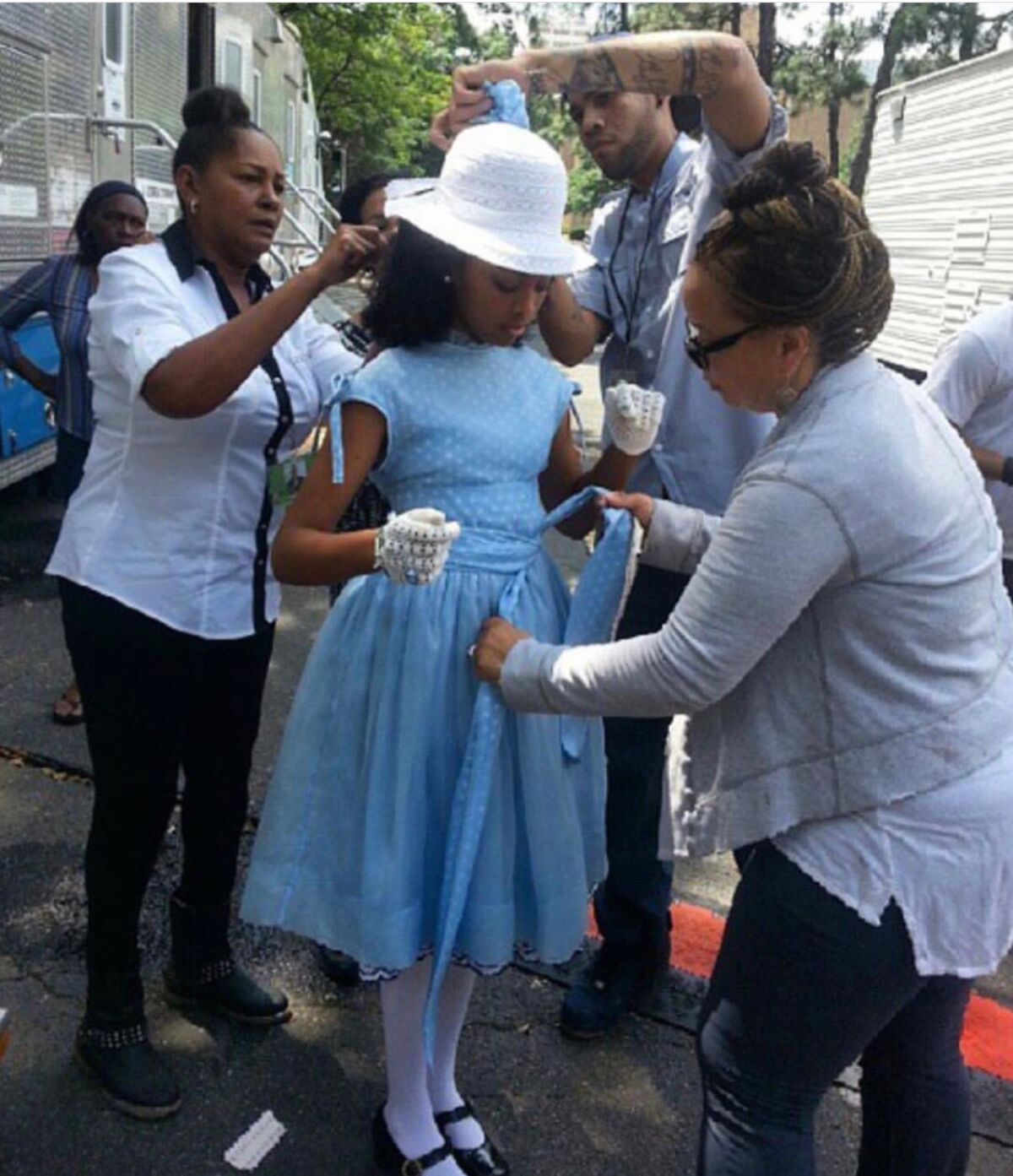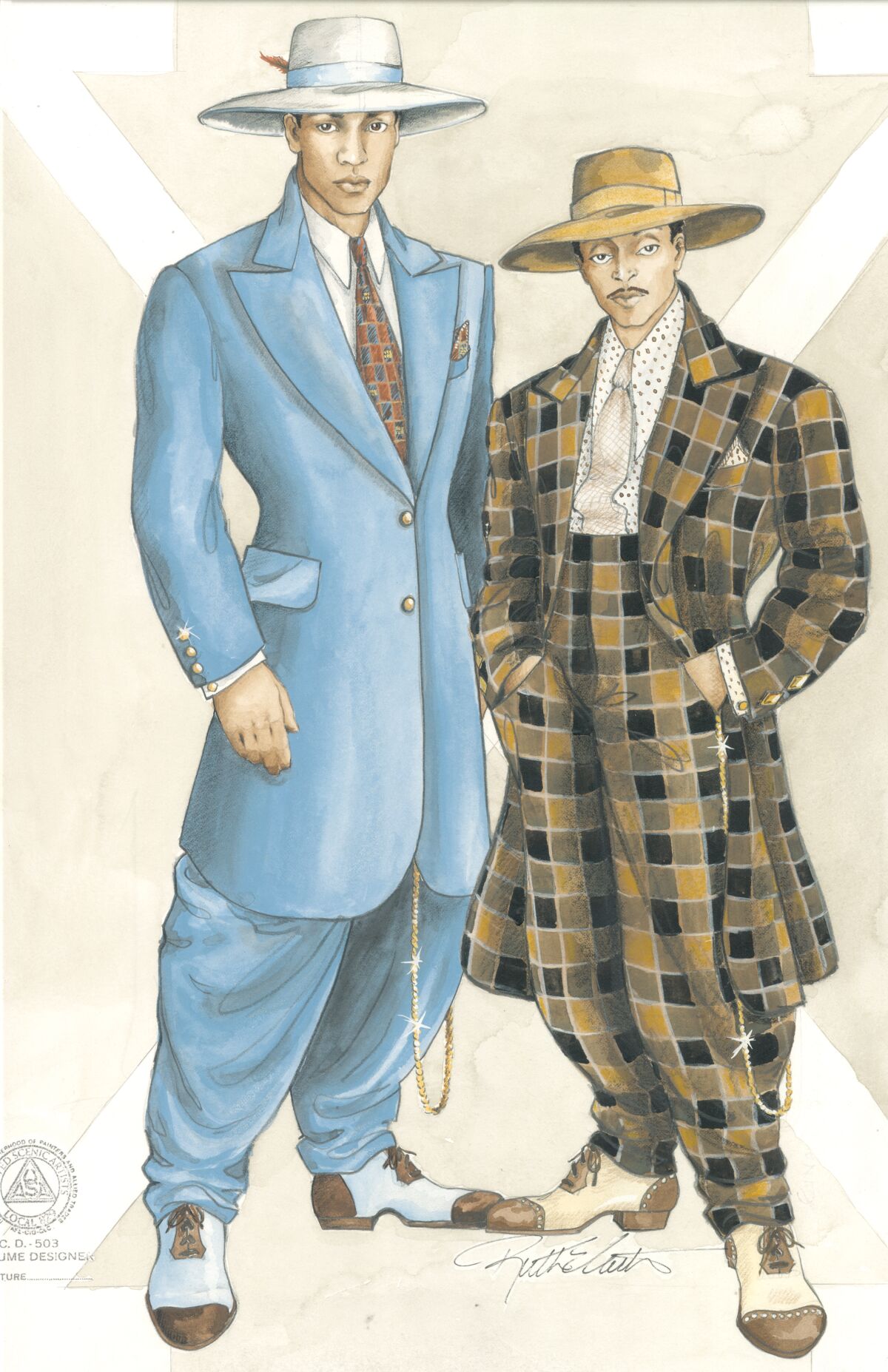Why Oscar-winning costumer Ruth E. Carter feels great about the state of Hollywood
On the Shelf
The Art of Ruth E. Carter: Costuming Black History and the Afrofuture, from Do the Right Thing to Black Panther
By Ruth E. Carter
Chronicle: 152 pages, $40
If you buy books linked on our site, The Times may earn a commission from Bookshop.org, whose fees support independent bookstores.
Earlier this year, legendary costumer Ruth E. Carter made history as the first Black woman to take home two Academy Awards.
Her win for 2018’s “Black Panther” was the first in costuming for a Black person and the first Oscar for Marvel Studios. Her second, for “Black Panther: Wakanda Forever,” marked another record: the first repeat in the category for an original film and its sequel.
Safely in the record books, Carter’s three-decade-long career is finally between hard covers too. “The Art of Ruth E. Carter: Costuming Black History and the Afrofuture from ‘Do the Right Thing’ to ‘Black Panther’” was released this week.
The slim volume offers rare photos, film stills, illustrations, sketches and mood boards from some of Carter’s 70 film gigs, including “Dolemite Is My Name” (2019), “Marshall” (2017), “Roots” (2016), “Selma” (2014), “Sparkle” (2012), “Four Brothers” (2005), “Baby Boy” (2001), “B*A*P*S” (1997) and others.
“Ruth Carter is a storyteller,” Danai Gurira writes in the book’s foreward. “She uses her craft to elevate a narrative, giving it an entirely richer and more potent delivery.”
Carter got her start in costume making through the theater department at Hampton University. There was no curriculum in costume design at the time, so she designed a program herself.
Her experience at the historically Black college came in handy during work on her first film, Spike Lee’s “School Daze.” “I knew how to do plays and how to get everything all organized, so I knew what the rhythm of making a film felt like,” she told The Times during a telephone interview from Atlanta, where she had been working on the upcoming “Blade.” “And then I did like 2.5 movies every year for 10 years.”

Ruth E. Carter backstage at the 95th Academy Awards holding her second Oscar, for “Black Panther: Wakanda Forever,” in March.
(Robert Gauthier / Los Angeles Times)
From film to film, Carter added, the budget doesn’t necessarily change the job. “I don’t think the process gets more sophisticated the bigger the film gets,” she said. “Like if I want a costume in there that we can’t spend a great deal of money on, I have to come up with a way to do it old school. I did a Maasai headdress out of a Pier 1 Imports beaded place mat. I think there is a core aesthetic that you keep and hold onto and that’s what makes you unique.”
In a conversation edited for length and clarity, Carter shares her favorite creations, looks she wishes she were responsible for and the ways she keeps her creative juices flowing.
Your two Oscars put you in the company of Denzel Washington and Mahershala Ali. How does it feel?
I feel that I’m with family. My first nomination was for “Malcolm X” with Denzel Washington. I was working [at the time] with Mahershala Ali on “Blade.” I feel a part of a wonderful family of artists who have achieved greatness and I’m accepting of their invitation.
Is there anything you can tell us about your work on “Blade” so far?
I sure can’t! But we got shut down because of the writers’ strike.
In your acceptance speech, you honored your mother, who died between your first and second win. How did she react the first time?
Winning the Oscar and thanking her just gave her so much joy. I know that she was proud of me. She was up there in age at that time — I think she was 97 — and kind of losing a little bit of her memory. I just know the mother that I’ve had my whole life. She’d be immensely proud.

Ruth E. Carter’s costume for the character of Zuri in “Wakanda Forever” in the touring exhibit “Ruth E. Carter: Afrofuturism in Costume Design” at the Museum of Pop Culture in Seattle.
(Museum of Pop Culture. From “The Art of Ruth E. Carter,” Chronicle Books 2023.)
What do you think is the hardest part of the job?
The pressure to get it right. When you’re representing cultures and you’re representing yourself — it’s never a burden, it’s a joy — but the pressure to get it right is like a calling. You have to do a deep dive, you have to ask questions, you have to not be afraid to ask for help.
After everyone had seen the first movie, there was no one that I could hire that didn’t feel that they knew Wakanda already. But I was showing another side of Wakanda and I was introducing [Talokan] so I still had to redirect all of those minds that were fixated on “I know what this is.” No, you don’t. We’re showing the river province and therefore we want to maybe bring in some other elements of design here. So it’s tough to guide and direct. I sometimes in my core feel insecure or shaky, and I have to ignore that and just push through and believe in myself. Because people talk all the time about appropriation but we’re honoring culture. And that’s why it’s important for me to retrain the eye to see beauty in new forms, new standards.
How do you replenish your creativity?
The whole time we were shooting and prepping “Wakanda Forever,” I had a life coach because the film was four times bigger than the first “Black Panther” and we’d lost our hero. We grieved through the process and we did a story about grief. And so through my life coach I did breathing exercises, yoga, weights, burpees… Anything to get out the energy that sometimes blocks creative thinking.
I also paint. I love the feeling of being in flow. Once you have your process of painting, it’s no different than working on a costume. It keeps me exercised with color theory, how to highlight, how to add shadows. It helps me communicate with my team when we come back together.
What are some of the most marked changes you’ve seen in the industry?
The independent filmmaker is now the Hollywood filmmaker. Before, the independent filmmaker was kind of obscure in a way. I did these films that were written, directed, produced by Robert Townsend and Keenan Ivory Wayans and I think they were by us and for us. Now the independent filmmakers are Hollywood icons. And you’ll see a film like “Moonlight” or “Everything Everywhere All at Once” win the Oscar, these smaller films that have so much heart. I think the independent film has grown up.
Do you have a favorite film that you’ve created a costume for?
I would say my favorite costumes were for “What’s Love Got to Do With It,” the story of Tina Turner. I could watch that film and watch Angela [Bassett]’s performance in that film and really love the journey. I forget that it’s a brutal story because I’m watching the costumes that I love so much!

Ruth E. Carter, right, dressing one of the girls for the church bombing scene in “Selma” on set.
(Courtesy of Ruth E. Carter. From “The Art of Ruth E. Carter,” by Chronicle Books 2023.)
Do you have a favorite costume of all time?
One is the beaded gold tier dress that Angela wears in the “Proud Mary” performance. It’s exactly a replica, bead for bead, of the dress that Tina Turner wore. And fortunately, Disney still has it. They don’t have anything else from that film, but they still have that costume. And I think the zoot suits from “Malcolm X,” because I studied the zoot suit in great detail in all of my menswear books and I feel like I nailed it.
Is there a film whose costumes you wish you made?
I loved “Elvis.” I loved “Ma Rainey’s Black Bottom.” And I love films like “Judas and the Black Messiah” where I can immerse in the story and don’t care about evaluating anybody’s costumes because they’re so great I just want to be an audience member. That’s how I felt with those films, that they gave their heart and soul to costume design.
What is the ratio of things you create from scratch to vintage or pre-made garments?
Well, sometimes it’s so vintage it can’t be worn but it can be recreated. So the percentage now, I would say, [compared to] when I did “Malcolm X” in 1992… It was 90% collection, rental pieces. Now, because vintage just keeps getting more scarce the older it gets, I would say that my latest films are 90-99% made from scratch.
What happens to costumes after a film ends? There doesn’t seem to be a cohesive process for costume preservation.
We costume designers could be picketing for better preservation of costumes. I know that they do have costume houses that get them through bartering after a film is finished. I have walked through costume houses in my career and said “Oh my God, that’s a zoot suit from ‘Malcolm X!’” I walked into a Hard Rock Cafe and saw Tina Turner’s dress from “What’s Love Got to Do With It” in a case on display and I go “Whose idea was that?” I have an exhibition that travels around of my work, but I had to cobble it together. I had to ask for costumes at the end of the films and pay to borrow a costume for the exhibition. I feel like I’m shedding a light on how we need to honor these garments. We didn’t look at costumes as an art form when I first started in this industry, and I think now more than ever there’s more attention to it.

Sketch for costumes to be worn by Malcolm X (Denzel Washington) and Shorty (Spike Lee) in the film “Malcolm X.”
(Art by Ruth E. Carter; Malcolm X © 1992 Warner Bros. All Rights Reserved. Courtesy of Ruth E. Carter.)
How would you describe the difference between theater costumes and film costumes?
Well, theater costumes are larger than life. There’s a distance between the stage and the audience member where the optical distance creates the loss of detail. In film, the small details and the textures really add to the telling of the story. I have this wonderful example in the film “Goodfellas.” Ray Liotta tells his babysitter — he’s all paranoid that the cops are looking [for him] — “I’ve got to go out. I’ll be right back. Don’t use the telephone.” And so of course when he leaves, she picks up the phone and calls her mom. And her fingernail polish is all chipped. And it was such a fantastic character choice.
What’s the biggest misconception about your job?
Because I’m a Black woman, they think I’m sewing. [People] immediately picture me behind a sewing machine. In many ways I am an art director. We’re storytellers and artists and we’re in charge of a big world. It’s a business, there’s a budget and we have deadlines and a lot of people involved that I have to manage. I think that people don’t realize that I have to have vision, I have to make all of the design decisions, but I collaborate with amazing artists.
Is there anything you wish people asked you more about?
It wasn’t until my first nomination that people started asking me about my filmography. And there are so many films in my filmography but people want to stick to the big — the “Black Panther” — but they don’t want to ask me about “Black Dynamite,” which I had a good time doing. I did “Yellowstone” for the first two seasons, I did “Seinfeld” and “In Living Color.” I’ve been doing this a lot longer than a lot of people. I’ve been doing this long before they invented Spanx, we’ll just put it that way.
For all the latest Entertainment News Click Here
For the latest news and updates, follow us on Google News.
